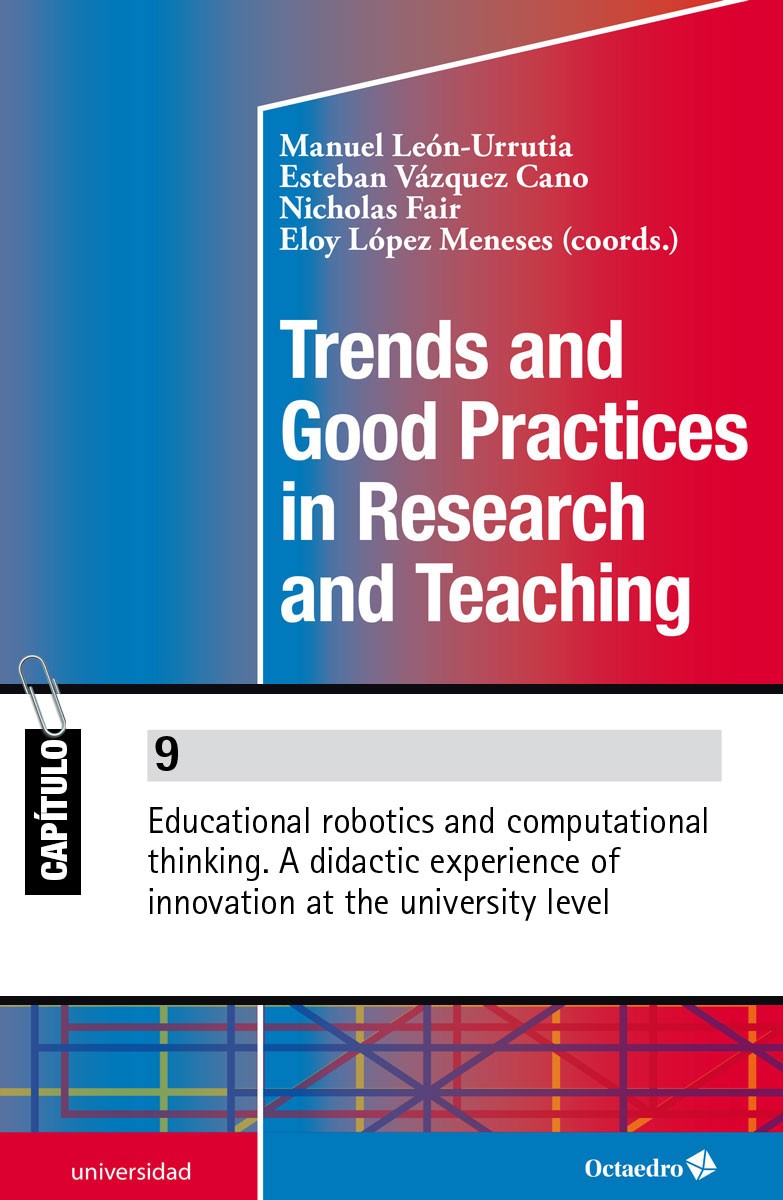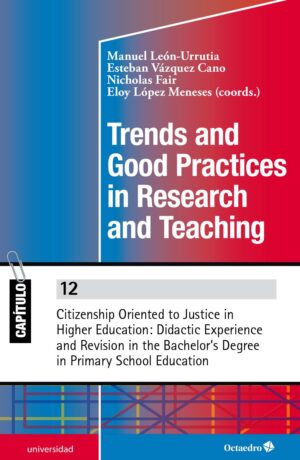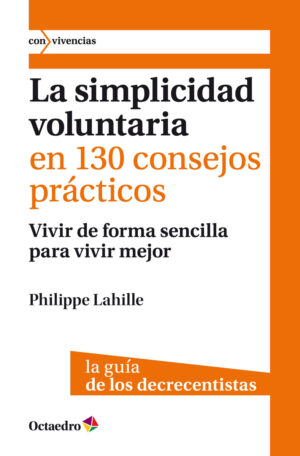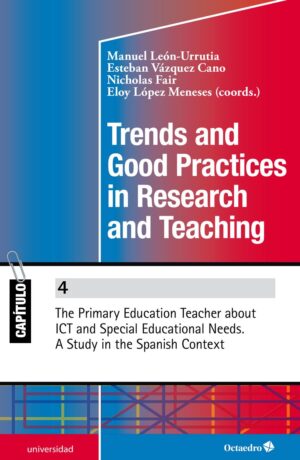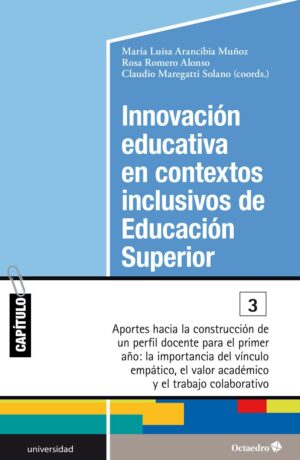FICHA TÉCNICA
Fecha de publicación:
01/01/2020
DOI: https://doi.org/10.36006/16184-09
Título del libro: Trends and Good Practices in Research and Teaching
URL del libro: Trends and Good Practices in Research and Teaching
ISBN:
DOI del libro: https://doi.org/10.36006/16184
Abstract
Educational robotics has thrived in recent years and is now gaining increasing presence in educational centres around the world. Although it has been especially significant in stages of secondary education, numerous introductory experiences have begun to be developed in stages of early childhood and primary education. The experience presented in this chapter aims to initiate a research line of educational innovation that will be focused on the didactic integration of the following types of robots: mBot, Mouse Robot and Makey-Makey board.
Palabras clave
Autores
Cómo citar
Román-Graván, P., Hervás-Gómez, C., Ballesteros-Regaña, C. (2019). Educational robotics and computational thinking. A didactic experience of innovation at the university level. En León-Urrutia, M., Vázquez Cano, E., Fair, N., López Meneses, E. (coords.) Trends and Good Practices in Research and Teaching. A Spanish-English Collaboration. Barcelona: Octaedro. https://doi.org/10.36006/16184-09
Referencias bibliográficas
- Acuña, A. L. (2012). Diseño y administración de proyectos de robótica educativa: lecciones aprendidas, Revista Teoría de la Educación: Educación y Cultura en la Sociedad de la Información, 13 (3), 6-27. Available at <http://hdl.handle.net/10366/121822>.
- Agatolio F., Pivetti M., Di Battista S., Menegatti E., & Moro M. (2017). A training course in educational robotics for learning support teachers. In Alimisis D., Moro M., & Menegatti E. (eds), Educational robotics in the makers era. Edurobotics 2016. Advances in Intelligent Systems and Computing (vol. 560). Springer, Cham. doi: <http://doi.org/10.1007/978-3-319-55553-9_4>.
- Alimisis, D. (2014). Educational robotics in teacher education: an innovative tool for promoting quality education. In Daniela, L., Lūka, I., Rutka, L., & Žogla, I. (2014), Teacher of the 21st century: quality education for quality teaching. Cambridge scholars publishing, pp. 14-27.
- Alimisis, D., Moro, M., Arlegui, J., Pina, A., Frangou, S., & Papanikolaou, K. (2007). Robostics & constructivism in education: the TERECoP project. In Proceedings of the 11th European Logo Conference. Comenius University, Bratislava.
- An, S. & Lee, Y. (2014). Development of Pre-service Teacher Education Program for Computational Thinking. In Proceedings of Society for Information Technology & Teacher Education International.
- Arlegui, J., Pina, A., & Moro, M. (2013). A PBL approach using virtual and real robots (with BYOB and LEGO NXT) to teaching learning key competences and standard curricula in primary level. In Proceedings of the First International Conference on Technological Ecosystem for Enhancing Multiculturality. New York: ACM, pp. 323-328. doi: <http://doi.org/10.1145/2536536.2536585>.
- Artym, C., Carbonaro, M., & Boechler, P. (2017). Evaluating pre-service teachers’ computational thinking skills in scratch. Ubiquitous Learning, 10 (2), 43-65. doi: <https://doi.org/10.18848/1835-9795/CGP/v10i02/43-65>.
- Atmatzidou, S. & Demetriadis, S. (2014). How to Support Students’ Computational Thinking Skills in Educational Robotics Activities. In Proceedings of 4th International Workshop Teaching Robotics, Teaching with Robotics & 5th International Conference Robotics in Education.
- Benitti, F. B. V. (2012). Exploring the educational potential of robotics in schools: A systematic review, Computers & Education, 58 (3), 978-988. doi: <https://doi.org/10.1016/j.compedu.2011.10.006>.
- Bers, M. U. (2008). Blocks to robots: Learning with technology in the early childhood classroom. New York, NY: Teachers College Press.
- —— (2010). The Tangible Robotics Program: Applied computational thinking for young children, Early Childhood Research & Practice, 12 (2). doi: <https://doi.org/10.1007/s10758-017-9328-x>.
- Bravo, F. A. & Guzmán, A. F. (2012). La robótica como un recurso para facilitar el aprendizaje y desarrollo de competencias generales, Teoría de la Educación. Educación y Cultura en la Sociedad de la Información, 13 (2), 120-136. Available at <http://campus.usal.es/~revistas_trabajo/index.php/revistatesi/article/view/9002/9247>.
- European Commission (2017). Digital Single Market. Available at <https://ec.europa.eu/digital-single-market/en/coding-21st-century-skill>.
- Ferreira, J.A., Ryan, L., & Davis, J. (2015). Developing Knowledge and Leadership in Pre-Service Teacher Education Systems, Australian Journal of Environmental Education. doi: <http://doi.org/10.1017/aee.2015.24>.
- Fredricks, J. A., Blumenfeld, P. C., & Paris, A. H. (2004). School engagement: potential of the concept, state of the evidence, Review of Educational Research, 74 (1), 59-109. doi: <https://doi.org/10.3102/00346543074001059>.
- Gorman, N. (2016). Teachers want more training before introducing robots into the classroom. Available at <http://www.educationworld.com/a_news/teachers-want-more-training-introducing-robots-classroom-1642632440>.
- Greenberg, J., McKee, A., & Walsh, K. (2013). Teacher prep review 2013 report. National Council on Teacher Quality. Available at <http://www.nctq.org/dmsView/Teacher_Prep_Review_2013_Report>.
- Kim, C., Kim, M. K., Lee, C., Spector, J. M., & DeMeester, K. (2013). Teacher beliefs and technology integration, Teaching and Teacher Education, 29, 76-85. doi: <http://doi.org/10.1016/j.tate.2012.08.005>.
- Kim, H., Choi, H., Han, J., & So, H. J. (2012). Enhancing teachersʼ ICT capacity for the 21st century learning environment: Three cases of teacher education in Korea, Australasian Journal of Educational Technology, 28 (6), 965-982. doi: <https://doi.org/10.14742/ajet.805>.
- Mataric, M. J., Koenig, N., & Feil-Seifer, D. (2007). Materials for enabling hands-on robotics and STEM education. In Proceedings of AAAI Spring Symposium on robots and Robot Venues: Resources for AI Education. Stanford, CA: American Association for Artificial Intelligence (AAAI).
- Osborne, R. B., Thomas, A. J., & Forbes, J. (2010). Teaching with robots: a service-learning approach to mentor training. In Proceedings of the 41st ACM Technical Symposium on Computer Science Education. New York, NY: Association for Computing Machinery (ACM), pp. 172-176. doi: <https://doi.org/10.1145/1734263.1734321>.
- Perritt, D. C. (2010). Including professional practice in professional development while improving middle school teaching in math, National Teacher Education Journal, 3 (3), 73-76.
- Pittí, K. (2014). Hoy hablamos con Katia Pittí, experta en robótica educativa, DROIDE, 2014. Available at <http://droidecomunidad.com/hoy-hablamos-con-kathia-pitti-experta-en-robotica-educativa>.
- Pittí, K., Curto, B., Moreno, V., & Rodríguez, M. J. (2013). Resources and features of robotics learning environments (RLEs) in Spain and Latin America. In Proceedings of the First International Conference on Technological Ecosystem for Enhancing Multiculturality. New York, NY, USA: ACM, pp. 315-322. doi: <http://doi.org/10.1145/2536536.2536584>.
- Quigley, C. F. & Herro, D. (2016). Finding the Joy in the Unknown: Implementation of STEAM Teaching Practices in Middle School Science and Math Classrooms, Journal of Science Education and Technology, 25 (3), 410-426. doi: <https://doi.org/10.1007/s10956-016-9602-z>.
- Román, P. & Hervás, C. (2017). Yes, you can: la robótica en la formación universitaria de maestr@s es posible, Comunicación & Pedagogía, 301-302, 49-52.
- Smith, M. (2016). Computer science for all. Available at <https://www.whitehouse.gov/blog/2016/01/30/computer-science-all>.
- Sullivan, F. R. & Moriarty, M. A. (2009). Robotics and discovery learning: Pedagogical beliefs, teacher practice, and technology integration, Journal of Technology and Teacher Education, 17 (1), 109-142. Available at <https://www.learntechlib.org/noaccess/26177>.
- Yadav, A., Mayfield, C., Zhou, N., Hambrusch, S., & Korb, J. T. (2014). Computational thinking in elementary and secondary teacher education, ACM Transactions on Computing Education, 14 (1). doi: <http://doi.org/10.1145/2576872>.
Mostrar referencias bibliográficas
- Acuña, A. L. (2012). Diseño y administración de proyectos de robótica educativa: lecciones aprendidas, Revista Teoría de la Educación: Educación y Cultura en la Sociedad de la Información, 13 (3), 6-27. Available at <http://hdl.handle.net/10366/121822>.
- Agatolio F., Pivetti M., Di Battista S., Menegatti E., & Moro M. (2017). A training course in educational robotics for learning support teachers. In Alimisis D., Moro M., & Menegatti E. (eds), Educational robotics in the makers era. Edurobotics 2016. Advances in Intelligent Systems and Computing (vol. 560). Springer, Cham. doi: <http://doi.org/10.1007/978-3-319-55553-9_4>.
- Alimisis, D. (2014). Educational robotics in teacher education: an innovative tool for promoting quality education. In Daniela, L., Lūka, I., Rutka, L., & Žogla, I. (2014), Teacher of the 21st century: quality education for quality teaching. Cambridge scholars publishing, pp. 14-27.
- Alimisis, D., Moro, M., Arlegui, J., Pina, A., Frangou, S., & Papanikolaou, K. (2007). Robostics & constructivism in education: the TERECoP project. In Proceedings of the 11th European Logo Conference. Comenius University, Bratislava.
- An, S. & Lee, Y. (2014). Development of Pre-service Teacher Education Program for Computational Thinking. In Proceedings of Society for Information Technology & Teacher Education International.
- Arlegui, J., Pina, A., & Moro, M. (2013). A PBL approach using virtual and real robots (with BYOB and LEGO NXT) to teaching learning key competences and standard curricula in primary level. In Proceedings of the First International Conference on Technological Ecosystem for Enhancing Multiculturality. New York: ACM, pp. 323-328. doi: <http://doi.org/10.1145/2536536.2536585>.
- Artym, C., Carbonaro, M., & Boechler, P. (2017). Evaluating pre-service teachers’ computational thinking skills in scratch. Ubiquitous Learning, 10 (2), 43-65. doi: <https://doi.org/10.18848/1835-9795/CGP/v10i02/43-65>.
- Atmatzidou, S. & Demetriadis, S. (2014). How to Support Students’ Computational Thinking Skills in Educational Robotics Activities. In Proceedings of 4th International Workshop Teaching Robotics, Teaching with Robotics & 5th International Conference Robotics in Education.
- Benitti, F. B. V. (2012). Exploring the educational potential of robotics in schools: A systematic review, Computers & Education, 58 (3), 978-988. doi: <https://doi.org/10.1016/j.compedu.2011.10.006>.
- Bers, M. U. (2008). Blocks to robots: Learning with technology in the early childhood classroom. New York, NY: Teachers College Press.
- —— (2010). The Tangible Robotics Program: Applied computational thinking for young children, Early Childhood Research & Practice, 12 (2). doi: <https://doi.org/10.1007/s10758-017-9328-x>.
- Bravo, F. A. & Guzmán, A. F. (2012). La robótica como un recurso para facilitar el aprendizaje y desarrollo de competencias generales, Teoría de la Educación. Educación y Cultura en la Sociedad de la Información, 13 (2), 120-136. Available at <http://campus.usal.es/~revistas_trabajo/index.php/revistatesi/article/view/9002/9247>.
- European Commission (2017). Digital Single Market. Available at <https://ec.europa.eu/digital-single-market/en/coding-21st-century-skill>.
- Ferreira, J.A., Ryan, L., & Davis, J. (2015). Developing Knowledge and Leadership in Pre-Service Teacher Education Systems, Australian Journal of Environmental Education. doi: <http://doi.org/10.1017/aee.2015.24>.
- Fredricks, J. A., Blumenfeld, P. C., & Paris, A. H. (2004). School engagement: potential of the concept, state of the evidence, Review of Educational Research, 74 (1), 59-109. doi: <https://doi.org/10.3102/00346543074001059>.
- Gorman, N. (2016). Teachers want more training before introducing robots into the classroom. Available at <http://www.educationworld.com/a_news/teachers-want-more-training-introducing-robots-classroom-1642632440>.
- Greenberg, J., McKee, A., & Walsh, K. (2013). Teacher prep review 2013 report. National Council on Teacher Quality. Available at <http://www.nctq.org/dmsView/Teacher_Prep_Review_2013_Report>.
- Kim, C., Kim, M. K., Lee, C., Spector, J. M., & DeMeester, K. (2013). Teacher beliefs and technology integration, Teaching and Teacher Education, 29, 76-85. doi: <http://doi.org/10.1016/j.tate.2012.08.005>.
- Kim, H., Choi, H., Han, J., & So, H. J. (2012). Enhancing teachersʼ ICT capacity for the 21st century learning environment: Three cases of teacher education in Korea, Australasian Journal of Educational Technology, 28 (6), 965-982. doi: <https://doi.org/10.14742/ajet.805>.
- Mataric, M. J., Koenig, N., & Feil-Seifer, D. (2007). Materials for enabling hands-on robotics and STEM education. In Proceedings of AAAI Spring Symposium on robots and Robot Venues: Resources for AI Education. Stanford, CA: American Association for Artificial Intelligence (AAAI).
- Osborne, R. B., Thomas, A. J., & Forbes, J. (2010). Teaching with robots: a service-learning approach to mentor training. In Proceedings of the 41st ACM Technical Symposium on Computer Science Education. New York, NY: Association for Computing Machinery (ACM), pp. 172-176. doi: <https://doi.org/10.1145/1734263.1734321>.
- Perritt, D. C. (2010). Including professional practice in professional development while improving middle school teaching in math, National Teacher Education Journal, 3 (3), 73-76.
- Pittí, K. (2014). Hoy hablamos con Katia Pittí, experta en robótica educativa, DROIDE, 2014. Available at <http://droidecomunidad.com/hoy-hablamos-con-kathia-pitti-experta-en-robotica-educativa>.
- Pittí, K., Curto, B., Moreno, V., & Rodríguez, M. J. (2013). Resources and features of robotics learning environments (RLEs) in Spain and Latin America. In Proceedings of the First International Conference on Technological Ecosystem for Enhancing Multiculturality. New York, NY, USA: ACM, pp. 315-322. doi: <http://doi.org/10.1145/2536536.2536584>.
- Quigley, C. F. & Herro, D. (2016). Finding the Joy in the Unknown: Implementation of STEAM Teaching Practices in Middle School Science and Math Classrooms, Journal of Science Education and Technology, 25 (3), 410-426. doi: <https://doi.org/10.1007/s10956-016-9602-z>.
- Román, P. & Hervás, C. (2017). Yes, you can: la robótica en la formación universitaria de maestr@s es posible, Comunicación & Pedagogía, 301-302, 49-52.
- Smith, M. (2016). Computer science for all. Available at <https://www.whitehouse.gov/blog/2016/01/30/computer-science-all>.
- Sullivan, F. R. & Moriarty, M. A. (2009). Robotics and discovery learning: Pedagogical beliefs, teacher practice, and technology integration, Journal of Technology and Teacher Education, 17 (1), 109-142. Available at <https://www.learntechlib.org/noaccess/26177>.
- Yadav, A., Mayfield, C., Zhou, N., Hambrusch, S., & Korb, J. T. (2014). Computational thinking in elementary and secondary teacher education, ACM Transactions on Computing Education, 14 (1). doi: <http://doi.org/10.1145/2576872>.
